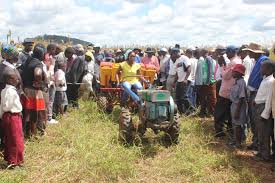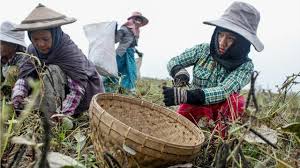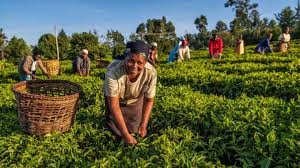One invariant in the life of all living and non-living things is change. When it takes place in the lives of interacting human beings, it is termed social change.
Social change occurs in all societies, slow, perhaps, in primitive and folk societies and rapid in complex modern societies. This article rural social change is the topic of discussion. The objectives below specify what is expected to be learnt after studying this article.
Understanding the Concept of Social Change in Rural Society
Social change involves a change in the structure or function of societal forms. Social interaction, involving social processes in society, takes place in accordance with existing norms and values in organisations, institutions and other societal forms without alteration in these societal forms and within their framework.
Social change, however, involves alteration in the structure and functioning of these values, norms, social roles, habits, obligations of people, or change in lifestyle, life goals, chances, environment or in the composition or organisation of their society.
When it is viewed within the rural setting, it is termed rural social change. The fact is that changes take place in the rural, sub-urban and urban areas. Change could be in all attributes of a societal unit such as in number, quality and importance.
It could be introduced from internal or external sources to the society or both. It could be planned, when it is more effective and predictable, or unplanned. It could be by force, when it is quick with early gains but not enduring, or voluntary, when it is slow but enduring. It could be total, when it is comprehensive, or segmental when it affects a part of the system.
Read Also: Amazon Flowers: All You Need To Know About
Types of Rural Social Change in Agricultural Communities

Many types of social change are noticeable in the lives of the rural population of the developing countries such as Nigeria. The various types of such changes are as follows:
1. Economic change: Rural areas of the developing world had undergone some degree of economic change, particularly during the post-independence era. In Nigeria for example, with the increased exploitation of petroleum resources, salaries have increased by more than 1,000 percent in government establishments over the past three decades.
A greater number of roads have been constructed to link rural with urban areas. Some dual carriage expressways have been constructed in the economically active parts of the country to link goods from the rural areas and major cities to the sea for export.
It must be admitted that changes in the processing, storage and distribution of economic goods have been rather slow. Storage of agricultural products such as maize, cowpeas and rice is still largely in bags, bottles, gourds, bare floor and ceilings of buildings.
The practice of storing in cribs is fairly satisfactory, while the use of silo for grain storage or refrigeration for preserving fresh fruits, fish and vegetables is becoming a common feature.
2. Political change: This is the change in the distribution and operation of social and political power. Democratically elected governments are now common in the less developed countries of the world. For example, in Nigeria, a democratic government has been in place since 1999.
Although when elections are held, there is constant accusation of rigging by the competing political parties. The law enforcement agencies are frequently accused of supporting one political party or the other.
The people therefore place little confidence in the electoral process of choosing political leaders, yet they have frequently failed to come up with a more acceptable formula.
Changes in the political organization through change in personnel running the political system could be advantageous if enough time is given each good government to fulfil its promises. Political change has the following advantages:
i. A government which is not responsive to the aspirations of the people can be changed
ii. Politicians who have outlived the peak of their effectiveness can be changed
iii. A tyrannical government can be changed
iv. People with better qualifications and greater enthusiasm to serve can be given the chance to serve
v. Political power can be distributed among the various social groups in a country
vi. The impact of political change is therefore witnessed in both rural and urban sectors of a country.
3. Technological change: This is the continuous process of change within the technical materials and physical practices and objects in a society. The early man started by making use of stones to produce fire and to hunt animals. Today technological change has resulted in using matches to prepare fire and guns to hunt animals.
Perhaps the most striking technological change in the rural areas has been in the area of farming. The changes have taken place in the physical, biological and cultural dimensions of agriculture. Within the physical sphere, the early man used sharp sticks to dig the ground for utilization.
Technological change in many less developed countries has resulted in the use of hoes and cutlasses for cultivation.
The use of tractor and its attachments such as trailers for haulage of farm produce and inputs, ploughs, harrows and ridges, is more popular in the developed than less developed countries of the world due to the following reasons:
i. Lack of spare parts to repair broken down machines
ii. Inadequate number of mechanics to repair the broken down vehicles
iii. Inadequate number of operators to handle the machines
iv. Inadequate observance of maintenance schedules
v. Poor adaptability of tools to soil types
The costs of the machines are too high for the small-scale farmers to afford. However, large government companies or private farms have used tractors and their attachments to their benefit over the years.
In the biological sphere of technological social change, improved varieties of crops and breeds of livestock have been introduced to farmers. The Ife Brown cowpeas which is upright with bunches of pods and more erect growth allow easier harvesting and more convenient cultural operations such as weeding than the spreading variety which it replaced.
In the chemical sphere, technological social change includes introduction of fertilizers to enrich poor soils and consequently crop yield, introduction of pest and disease control chemicals and others.
Technological change has taken place in other sectors of rural life apart from agriculture. Use of vehicles has largely replaced trekking from villages to the town or market. Widespread use of radio provides entertainment and current affairs programmes.
Kerosene stoves have replaced firewood for providing cooking fire in some homes. Corrugated iron sheet roofing has replaced thatched roofs. Technological change therefore takes place in all parts of the rural community, namely the farm, home and community.
4. Cultural change: Culture consists of material and non-material aspects. Cultural change is therefore alterations in the non-material and artifacts of the society. The material aspect of cultural changes is mainly technical. Examples are use of aluminium cooking pots instead of clay pots, use of metal eating plates and utensils instead of clay plates and wooden utensils.
The change in non-material aspects of culture are also numerous. If the institution of the rural family is considered as a social system in terms of its elements and processes, the cultural changes which had taken place can be elucidated with some examples.
The objective of a typical rural family, in many parts of Nigeria particularly in the South, has shifted from marrying for their children and settling them in farming to assisting them to acquire formal education, or at least undergo technical apprenticeship training and then settle to profitable employment.
The norm of not calling elders by name still persists as a reflection of the value of respect for age which is universally resistant to change.
5. Behavioural change: This includes favourable change in the knowledge, skill and attitude of people as a result of their exposures to educational experiences. Residents of rural areas are exposed to information which has led to acquisition of better knowledge, skill and attitude in the economic and social spheres.
Agriculture is the major occupation of rural people. Improvements in knowledge of crop and livestock pest and disease control measures, higher-yielding crop varieties, better spacing of crops, weeding, cultivation, harvesting, processing, storage and marketing operations had taken place.
The skill to practice such knowledge is also taught largely by agricultural extension workers through the method demonstration technique. In Nigeria, educational change had resulted from increase in number of schools in the rural areas, and change in the system of education to 6-3-3-4.
6. Changes in the use of leisure through recreation: One social sector which had witnessed a noticeable social change in rural areas of Nigeria had been in the use of leisure through the recreational sector. In many parts of the country, particularly in the urban areas, parks, flower gardens, swimming pools and zoological gardens for animals have been established as holiday resorts for the citizens.
Some game reserves have been established in rural areas. However, rural entertainments which made the village life enjoyable such as hide and seek games during the full moon, competitive wrestling, routine and competitive swimming, some village band sets have virtually disappeared.
These recreational opportunities should be modernised to contribute to the quality of rural life, rather than allow them to die.
Read Also: Pumpkin Flowers (Pumpkin Blossoms): Complete Growing and Care Guide
Barriers to Rural Social Change in Agriculture

1. Cultural Barriers to Change
The values and attitudes of a culture as embodied in its tradition determine how receptive it is to change. Some cultures view change with scepticism; others with excitement. Conservative forces within the rural community can be identified with the former.
Some rural communities are fatalistic in their approach to nature and the social environment; others may have a tradition of striving to conquer nature and the social environment. Fatalistic attitudes are sometimes intimately linked with a people’s religious beliefs.
Some cultures may reject innovations because of their belief in their relative cultural superiority (cultural ethnocentricity). Science and technology the principles of which are in any case universal can be compared across cultures. It is however difficult to cross-culturally compare social forms, values, institutions, etc.
In many rural communities, new programmes have failed because they did not synchronise with accepted and well-defined roles in society. Sometimes innovation programmes are grounded because relative values are not sufficiently taken into account.
In the case of new varieties of maize in Western Nigeria and New Mexico the quality factor turned out to be very important. In the trade-off between quality and quantity of maize, strong preference was revealed for taste at the expense of quantity from increased yields of the new variety.
Another cultural barrier to change occurs when demands of innovations are inconsistent with established cultural traits and values. In some Buddhist countries for instance, the religious sanction against the taking of life in any form interferes seriously with pest control programmes that rely on the use of insecticides. Sometimes such incompatibilities can be ingeniously rationalised so that the innovations can win acceptance.
2. Social Barriers to Change
There are four main factors here:
i. There is the primacy of some key social units in many cultures: the family, the kinship, the friendship group, the old school-tie group, etc. Within these groups, mutual obligations and reciprocal relationships exist. The related demands of group loyalties are frequently inconsistent with the demand of industrialisation and the progressive individualisation of values that usually accompanies it.
ii. The rural community may be traditionally split into factions. Attitudes to genuinely useful innovations come to be defined in terms of the roles of leaders and members of the factions in the promotion of the package. General adoption by most of a given rural community is impeded by factional divisions within the community.
iii. Locating the centres of authority within the rural community as they relate to decision making as to whether or not to adopt a particular innovation package is often a challenge.
iv. Rigid social classes inhibit the free flow of ideas across all strata of society, especially where the distribution of political power is also along class lines. These rigidities also exist within the bureaucracies of many Ministries of
Agriculture and Extension services. Subordinates are rarely encouraged to criticise their superiors, seriously obstructing the feedback mechanism of communication.
As a result, field problems are not adequately relayed to superiors who consequently possess incomplete information about the actual field situation.
3. Psychological Barriers to Change
There are three main problems here:
First is the problem of differential interpretation and/or perception of an innovation. An innovation may be viewed by the rural community in a completely different light from that viewed by the extension agent.
Second, communication difficulties arise, particularly in the multi-ethnic societies of Africa. In most of these countries, extension ministries promote most of the new agricultural programmes. Where extension personnel do not speak the local language properly, effective communication between agents of change and recipients of change breaks down.
Third, learning problems may arise. Rural people must have no resource constraints to learning, must be given an opportunity to experiment without undue financial commitment, and the agent of change must be physically present during the learning process.
For example, in a new agricultural programme such as the promotion of fertilizer use, field overseers, agricultural assistants and other extension personnel must be continuously present during the planting season to advise farmers on application rates, etc.
Do you have any questions, suggestions, or contributions? If so, please feel free to use the comment box below to share your thoughts. We also encourage you to kindly share this information with others who might benefit from it. Since we can’t reach everyone at once, we truly appreciate your help in spreading the word. Thank you so much for your support and for sharing!

